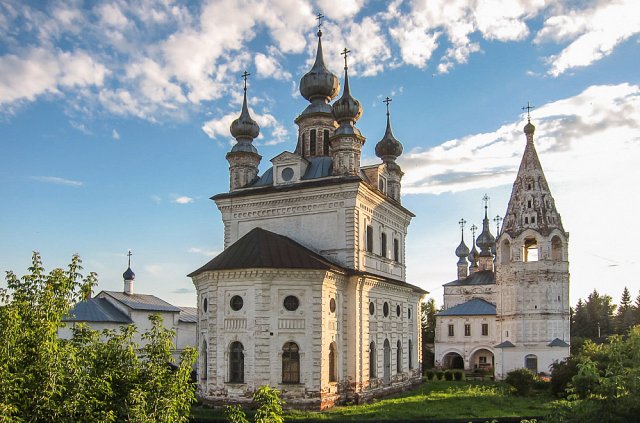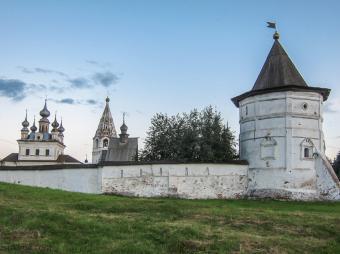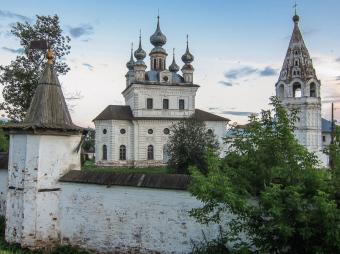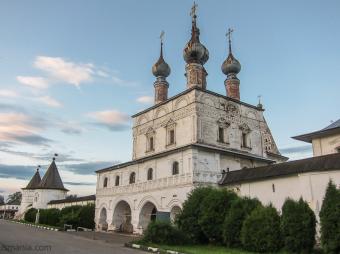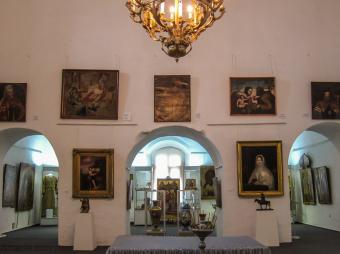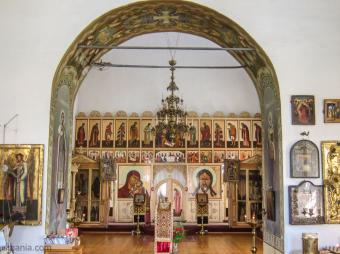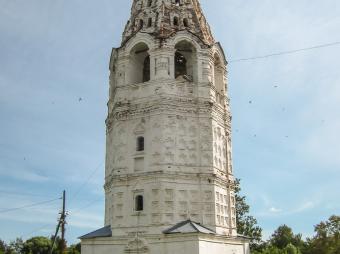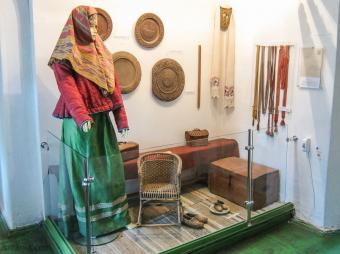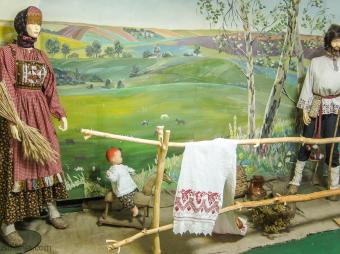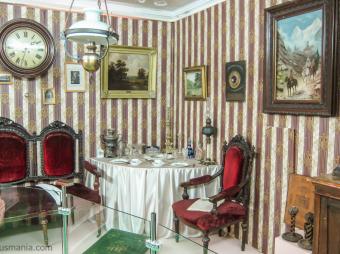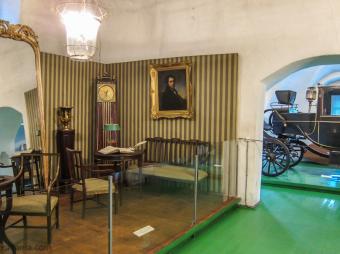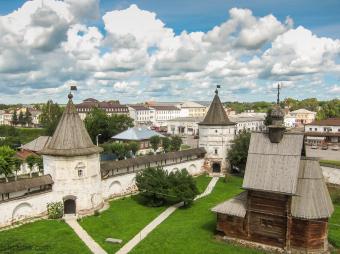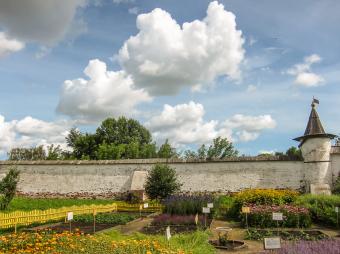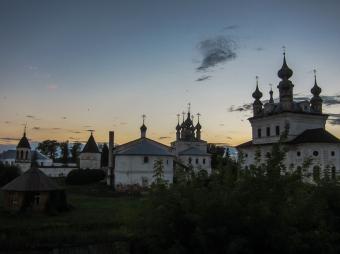Inside the Earthen Mound
Mikhailo-Arkhangelsky Monastery

The Mikhailo-Arkhangelsky Monastery was founded sometime in the 13th century during the reign of Prince Svyatoslav Vsevolodovich of Yuriev-Polsky within the boundaries of the earthen mound and fortress. However in 1238 it was destroyed by the forces of Batu Khan during the Mongol-Tatar Invasion of Rus. It was only re-established in the mid-16th century when its gained its first stone building. Further stone construction work took place in the 17th century when more buildings and stone walls and towers were added. During the Soviet period the monastery was closed and used to house the Yuriev-Polsky Historical, Architectural and Art Museum. Now most of the buildings remain part of the museum, although the monastery was re-established once more in 2004 and allocated part of the territory and Archangel Michael's Cathedral.
St John the Theologian's Church
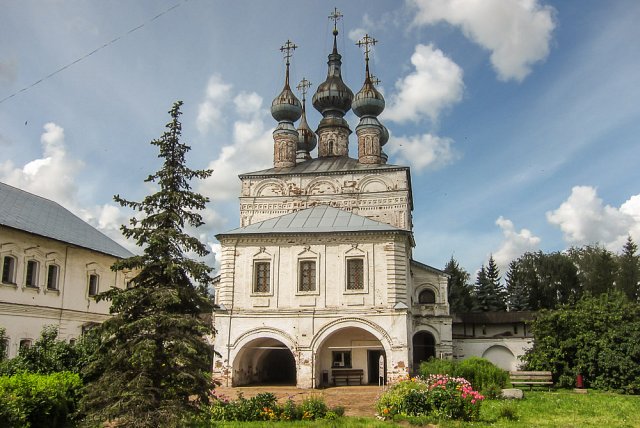 The main entrance to the monastery is served by the Holy Gates which dates from 1654. St John the Theologian's Church was built over these gates and was completed in 1670. In form the gate-church represents a four-tiered structure with five domes surrounded by a closed gallery.
The main entrance to the monastery is served by the Holy Gates which dates from 1654. St John the Theologian's Church was built over these gates and was completed in 1670. In form the gate-church represents a four-tiered structure with five domes surrounded by a closed gallery.
The church was closed in the Soviet times and today it remains part of the museum, housing an art gallery, displaying works of art demonstrating the development of Russian art through the ages. It features ancient icons which were made in the Yuriev-Polsky District and once used in the monastery's churches, as well as paintings and examples of Russian, Oriental and European china. The first floor of the cathedral is taken up with the ticket office and a souvenir shop.
Archangel Michael's Cathedral
The monastery's main cathedral is the Archangel Michael's Cathedral. The cathedral was built between 1772 and 1806 to replace an early stone version which dated from 1560. The new cathedral however was built in the style of the previous 16th century version and so it has a much more ancient appearance. During the Soviet years the cathedral was closed and used as an exhibition of carved wooden church decorations. Today the cathedral has been returned to the Orthodox Church and is now the only functioning cathedral of the Mikhailo-Arkhangelsky Monastery, although it still holds some of its former displays.
One of the most famous features of the Mikhailo-Arkhangelsky Monastery is its bell tower which dates from between 1685 and 1688 and stands just outside Archangel Michael's Cathedral. The top of the bell tower takes the form of a tent dome which is rather rare in Russian church architecture. Today it is possible to go to the top to see the bells and more importantly enjoy great views of Yuriev-Polsky.
Archimandrite's Chambers
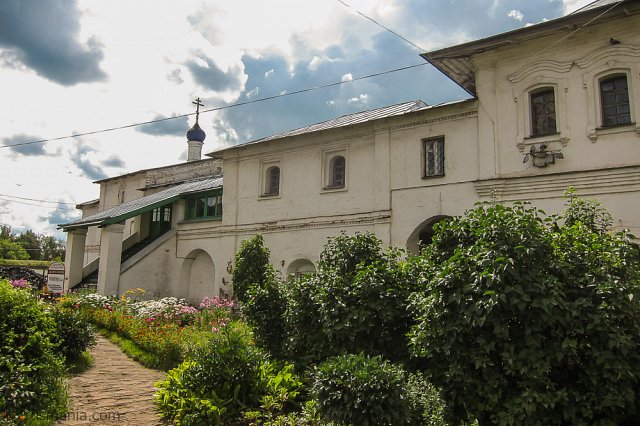 The southern side of the monastery is occupied by the archimandrite's chambers which include the Our Lady of the Sign Church. The structure was completed in 1625 and is typical in design for that period of time. The building is now used by the museum to hold two permanent exhibitions. On the first floor there is an exhibition on Peasantry and Farming of the Vladimir Opolya which details the history of the region and displays old farming tools. The second floor is dedicated to the History of the Textile Industry of the Yuriev-Polsky District and shows the tools of the trade as well as mock-ups of merchants' houses.
The southern side of the monastery is occupied by the archimandrite's chambers which include the Our Lady of the Sign Church. The structure was completed in 1625 and is typical in design for that period of time. The building is now used by the museum to hold two permanent exhibitions. On the first floor there is an exhibition on Peasantry and Farming of the Vladimir Opolya which details the history of the region and displays old farming tools. The second floor is dedicated to the History of the Textile Industry of the Yuriev-Polsky District and shows the tools of the trade as well as mock-ups of merchants' houses.
The Bagration Exhibition inside the former Our Lady of the Sign Church is dedicated to the prominent general and hero of Russia's Patriotic War of 1812 against Napoleon. Bagration has a special connection with Yuriev-Polsky as after his injury during the Battle of Borodino he was brought to his relatives' estate in nearby Sima where he died and was originally buried (later his body was reburied at Borodino Field). This exhibition now holds many items transferred from the estate in Sima, including a carriage, and has recreations of the rooms. It also contains materials on the course of the 1812 War.
St George's Church
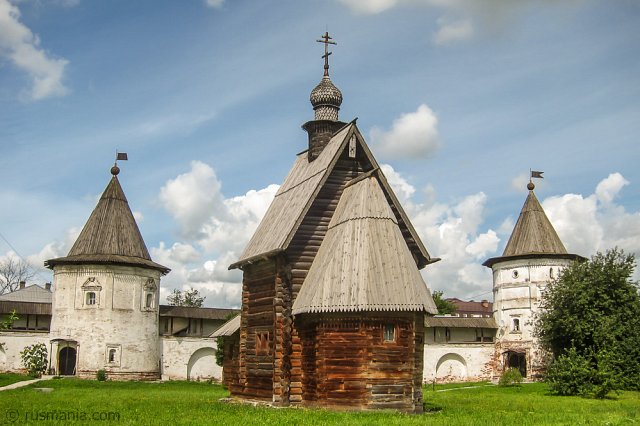 The small wooden St George's Church was not originally part of the Mikhailo-Arkhangelsky Monastery. It was built sometime in the early 17th century and used to stand in the village of Yegorie in the Yuriev-Polsky District as part of the Georgievsky Monastery which no longer exists. It was brought to the Yuriev-Polsky Historical, Architectural and Art Museum in 1968 so that it could be better preserved.
The small wooden St George's Church was not originally part of the Mikhailo-Arkhangelsky Monastery. It was built sometime in the early 17th century and used to stand in the village of Yegorie in the Yuriev-Polsky District as part of the Georgievsky Monastery which no longer exists. It was brought to the Yuriev-Polsky Historical, Architectural and Art Museum in 1968 so that it could be better preserved.
| Location | 4 Ulitsa 1 Maya |
|---|---|
| Clock | 09:00 - 17:00 (Mondays: 09:00 - 14:30). Closed on Tuesdays and the last Friday of the month. |
